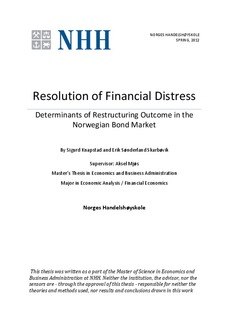Resolution of financial distress : determinants of restructuring outcome in the Norwegian bond market
Master thesis
Permanent lenke
http://hdl.handle.net/11250/169715Utgivelsesdato
2012Metadata
Vis full innførselSamlinger
- Master Thesis [4372]
Sammendrag
This thesis analyses possible determinants explaining restructuring outcomes for financially
distressed firms in the Norwegian bond market. This includes both Norwegian firms and
foreign firms issuing bonds in the Norwegian market, restricted to bonds issued or matured
in the seven year period between January 1st 2005 and December 31st 2011.
Our findings indicate that firms resolving financial distress only by postponing obligations
have better financial performance, are larger measured in total assets and sales, and have
significantly lower interest expenses to sales than all other firms involved in a credit event.
Further, liquidated firms are financed by significantly more public debt, and more of their
debt is senior secured than firms succeeding to restructure. They also have significantly less
intangible assets than debt restructuring firms. Fewer of the liquidated firms have access to
bank financing, but given that a firm has access to such financing we found no substantial
difference either in levels or the importance of determinants compared to firms without bank
debt. Somewhat surprisingly, firms restructuring by selling assets have significantly more
convertible debt.
As opposed to previous research on U.S. firms, we find no significant effect of the level of
trade credit, current ratios or leverage measured by debt level. This may be due to a limited
sample size.
